Whether you are in the B2C or B2B industry, keyword research is the most important aspect of any marketing campaign. And when it comes to SEO, you should put it at the highest priority.
If you’re writing about things that your target audience isn’t searching for, you’re not going to get any traffic from search results.
You need first to identify the keywords and the search queries that your target audience is using to search for information related to your products or services.
And then create content to help them find answers and get them to know your brand. This whole process of discovering relevant keywords you want to rank for is known as keyword research.
In this article, I will show you how to do keyword research for B2B audiences to drive quality traffic to your site and generate more leads for the business.
If you are ready, let’s get started.
Step-by-step guide conduct B2B keyword research
There are plenty of ways to do B2B keyword research – you can opt for the manual way or use an online tool. Despite the way that you choose, there are a few steps that you must follow to research and find the right keywords for your business website.
Here is your step-by-step guide to keyword research:
Step 1: Study your niche
The first step in researching the keywords is jumping deep into your niche. In this step, your objective is to analyze and determine how your target audience defines your brand, product, and services.
You will find the topics and queries that can be pillar keywords for your SEO strategy.
You can study your niche in the following 3 ways –
- Connect with existing customers: You can start interacting with your customers, actual and potential alike, to discover their behavior. Ask them about the terms they will use to describe your brand, business, company, or industry.
- Reach out to the potential audience: You can put a similar question to potential customers by asking them to recommend your brand to their friends. It will help you understand the perspective of the audience that you want to target.
- Check different forums: Forums are the best places to find the questions people are asking about your industry and the solutions your company is offering. For example, if you’re in the manufacturing industry, search for the keyword “manufacturing,” and find a subreddit r/manufacturing.
In this subreddit, you can find queries from people to use for your content strategy. Just look at this question on Reddit –

Similarly, on the search for different keywords related to your products and services, you may find this type of queries that most of your target audience might be searching for –

And here’s another one.

Just spend some time strolling around on different forums and you’ll get a lot of amazing keyword ideas for your business.
Step 2: Make a list of seed keywords
Once you have studied and defined your niche, create a list of seed keywords. A seed keyword can relate to various topics, and it must be something that your target audience searches online.
These keywords are essential as they form the foundation of the entire keyword research. 71% of users start their search with a generic search.
You can use survey tools like Survicate to conduct online surveys to find the keywords people use to search for your services. If you are just getting started and don’t have the connection or resources to do a survey, start by describing your product or service in the simplest terms possible and think about how people will search for it online.
For example, let’s say you’re in the shoe manufacturing industry, then your seed keywords can be – “Shoe manufacturer”, “Shoe supplier”, “leather shoe producer” etc.
Similarly, the seed keywords for SaaS-based companies can be related to their product features and solutions like email marketing CRM, POS software, marketing automation software, accounting software, etc.
Following this idea, choose the most common keywords related to your products and services and then add them to your seed keywords list.
Step 3: List out what keywords your competitors are ranking for
The next step of B2B keyword research is assessing the keywords that your competitors are ranking for. This is the best step because it helps you save a lot of time finding the best keywords that can drive quality traffic to your site.
Before you begin analyzing the competitor’s strategy, you must find out who your competitors are on search result pages. You can simply put in the seed keyword on Google and manually list out the top 10 pages appearing on the result page.
Or you can use Semrush to export the list for you. Just go to the Semrush Keyword Overview tool and enter your primary keyword in the search bar.
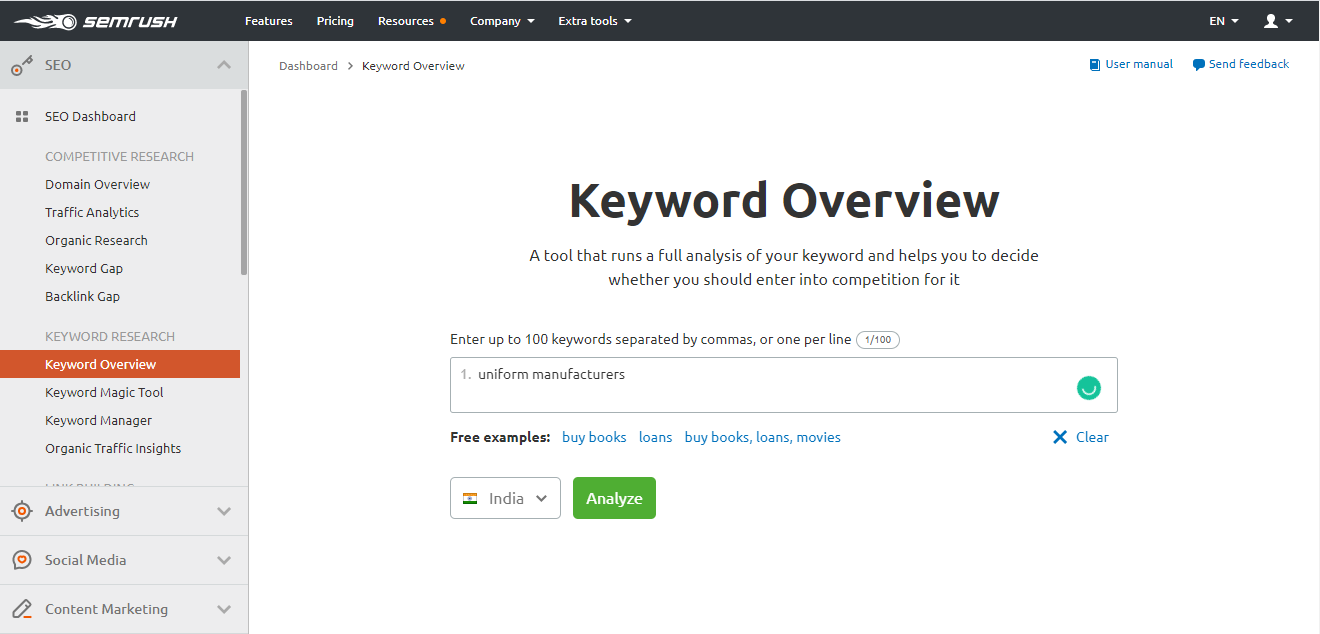
Now, scroll down, and you’ll find a SERP analysis report that lists the top 10 search results for the entered keyword. These are your competitors.
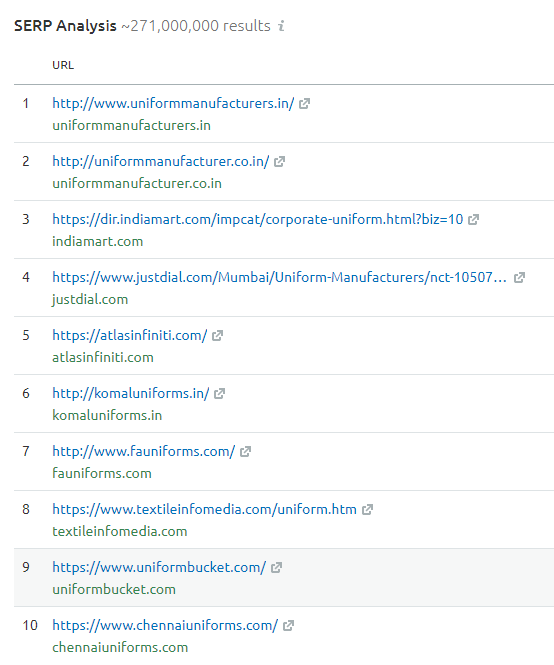
Click on one of the URLs in the list and you’ll see the top organic keywords for uniformmanufacturers.in –
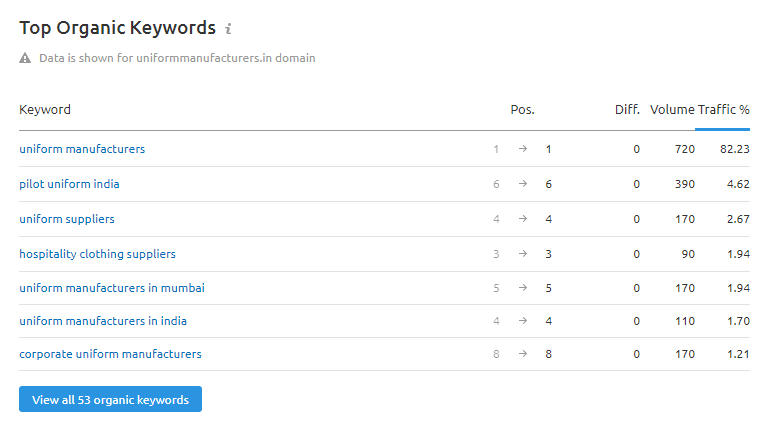
Click the View all organic keywords button and export it. Follow the same step export the top-ranking keywords for each competitor and add it to your Google Sheet (you’ll know why in the later section).
Step 4: Find related and long-tail keywords
By now, you have a good chunk of keywords that are very relevant to your brand and what you offer. But that’s not enough because not all of the audience uses the exact keywords to search.
You need to find more keywords related to your seed keywords that your target audiences are searching for. And these are the 3 best methods that you can use –
1. Use Google Suggestions
Enter your primary keyword in the Google search bar, and you’ll see a list of suggestions that other people are searching for. These keywords are the most searched query on Google related to the keyword you entered in the bar.
Just take a look at the Google suggestions when I entered “uniform manufacturer” in the search bar.

Now, after clicking on the search button, you’ll see these related searches at the end of the result page.

In the suggestions, you can see that most of the queries are locality-based. This shows that you may have to focus on your local SEO strategy. All these suggestions are long-tail keywords that show how crucial long-tail keywords can be for your SEO strategy.
Now add these suggested keywords to your Google sheet and follow the same step for each of your seed keywords.
2. Use Google Keyword Planner
Google Keyword Planner is a free keyword research tool mainly created to help you with the Google Ads campaign. But you can use it to get more keyword ideas.
Go to Google Keyword Planner, Sign up with your existing Google account, and click on the “Discover new keywords” tab.
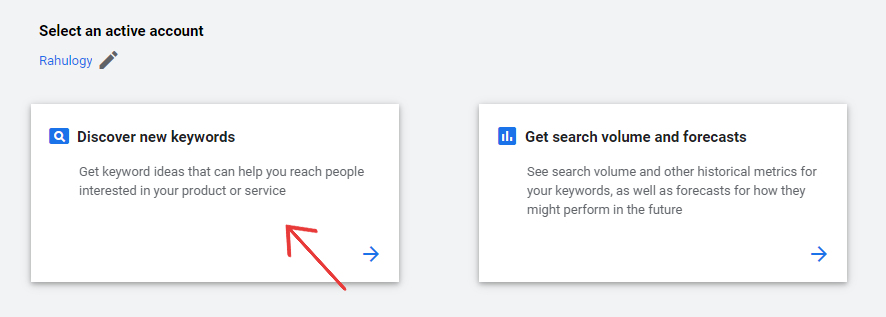
Now, enter your seed keyword(s) in the search bar and click the “Get results” button.
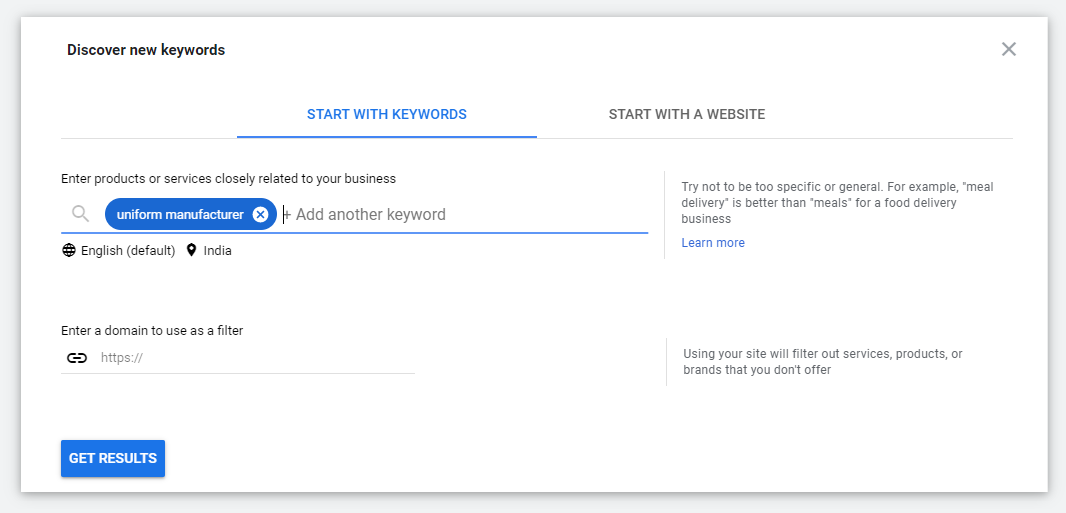
Now, you’ll see an entire list of keyword ideas related to your primary keyword(s) along with the average monthly search volume and competition level.
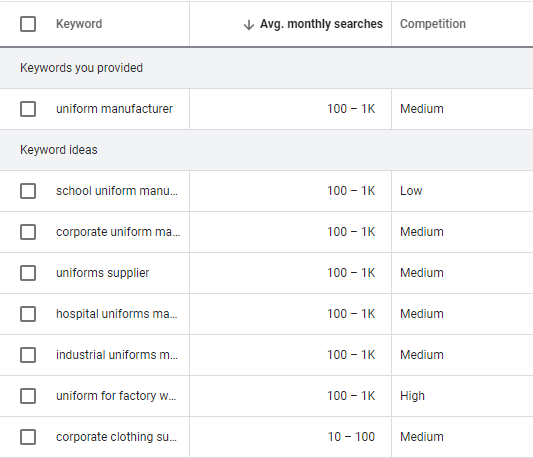
Download the list and exclude the keywords with less than 100 average monthly searches, which will give you another set of potential keywords for your business.
3. Use SEMrush Keyword Magic Tool
Go to Semrush Keyword Magic Tool. Enter your primary keyword and click search to get a list of all the related keywords.
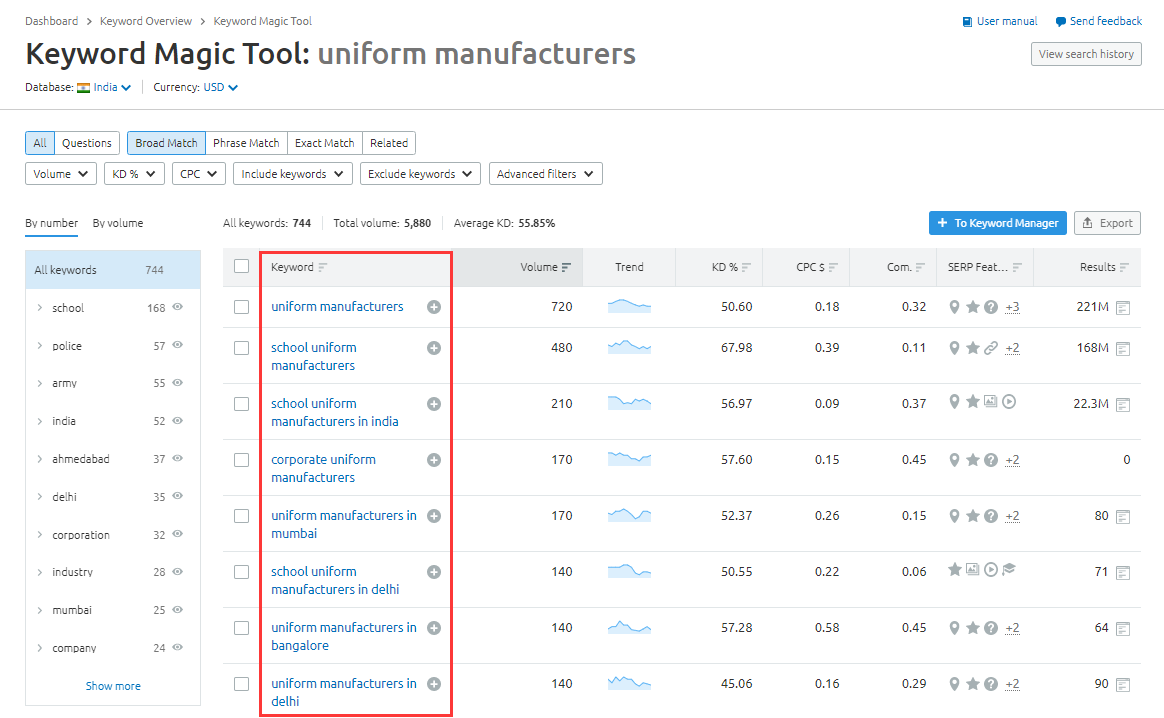
Here you can see the search volume, Keyword Difficulty, and competition metric for each of the listed keywords. Add a filter to see the keywords with 100+ search volumes and export it.
Step 5: Analyze and choose relevant keywords
Now, you have a list of all the potential keywords; but in order to create an effective SEO strategy, you need to identify the best keywords to get started.
So, how do you find the best keywords for your website? The answer is simple – analyze and compare the keywords based on the following metrics –
- Search volume
- Trend
- Keyword Difficulty
- Cost Per Click (CPC)
- Competition
If you have exported the keyword list from Semrush, you have already got these metrics in your report. And for the keywords that you have found from Google search suggestions and Keyword Planner, you can use the Semrush Keyword Overview tool to get the metrics for all your keywords.
You just have to copy and paste all the keywords in the search box and click the “Analyze” button. Here are the keywords I found from Google search suggestions and related searches (refer to the earlier images)-
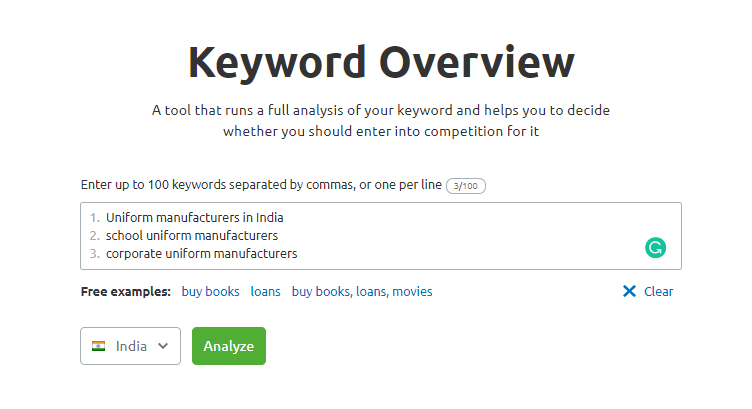
Now, you’ll see all the keywords you entered with all the metrics in the tabular form –

Export the list and add the data to your Google Sheets. Now, you have all the keywords with the metrics to analyze and find the best keywords for your business.
The best keywords are those with high search volumes, low keyword difficulty, and high CPC.
Remember that the search volume of B2B-specific keywords is usually very low (100-1000). So, set the benchmark to the lowest search volume for your keywords based on the average search volume of the most popular keywords in your list.
Once you have shortlisted the keywords, remove the irrelevant keywords from the sheet, and move to the next step.
Step 6: Group keywords by search intent
Now, you have the complete list of relevant keywords. You would want to pick the keywords with the most ranking to increase your traffic.
While this easy trick might have worked earlier, it isn’t so simple anymore. With the continually evolving algorithm, Google now compares search terms with user queries to understand their intent and ranks the pages to meet the searcher’s intent.
Search intent is the reason or intent behind the audience searching for a particular term or query. The search Intent of users can be categorized into the following 4 types-
- Informational – “Types of textiles for uniform” “Best security uniform designs”
- Navigational – “your company name”
- Commercial – “Best uniform manufacturer in Mumbai”, “Best school uniform supplier in Delhi”
- Transactional – “School uniform quotes”, Buy Uniform…
Not only from an SEO perspective, but it is also a great idea to create content keeping the user intent in mind so that you can drive more conversions.
Now group all selected keywords by the search intent and move to the next topic.
Step 7: Create a list of relevant topics
The next step is creating a list of topics for respective keywords based on different search intent.
Once you have analyzed why your audience is searching for a particular keyword, you can list relevant topics for different search intents.
Step 8: Link the topics to the B2B buyer’s journey map
The journey of a B2B is relatively long and can take 6 to 12 months to complete. The buyer’s journey represents how an unknown person gets to know about a new brand and moves toward the purchasing decision.
You can map the topics you have collected in the previous step to different stages of the buyer’s journey. Here are my tips to help you link the topics to different stages.
- Awareness: In this stage, the user is aware of the problem and is looking for the possible solutions available to them. You can map topics that pertain to helping the audience with the research and address common issues in your niche.
- Consideration: The consideration stage is where the buyer may have shortlisted some vendors to help them with the problem. You must focus on telling them how your offering is better than the rest.
- Decision: At the last stage of the decision, the potential buyer wants to learn the specifics of your product or service before buying. You must focus on providing the required information to the audience to win their trust and get them on board.
Wrapping Up
While people often call ‘content’ the king, ‘SEO’ is the queen; with a comprehensive keyword research-backed SEO strategy, you can target specific business clients.
It can help you generate traffic to your website, build a return client base, engage with potential clients, and give a boost to sales and revenue. Researching keywords can be a time-consuming and tedious task, but the efforts pay off in the end.
Above all, to conduct successful keyword research for your business, you will need a powerful keyword research tool as well. And my favorite is Semrush. It is a complete package of SEO tools that you will need to grow your website ranking on Google.
Here are a few handpicked articles related to SEO that you might want to read –
- Effective link-building strategies for B2B websites
- Simple SEO hacks to grow organic traffic on your website
